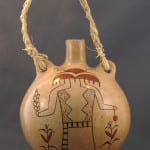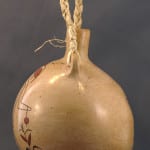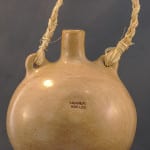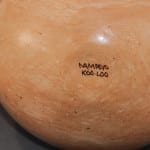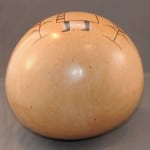Utilitarian canteens to haul water up the mesa to a home or carry a day’s supply of water into a field were common utilitarian items until the early part of the 20th Century. (See utilitarian ware in the Index of Categories.)
The shape of these canteens was generally bulbous to maximize capacity. About 1900, Nampeyo and other Hopi and Hopi-Tewa potters began making miniature canteens for sale. Too small to be useful, these tourist items often had a flat front to maximize the space available for decoration. While made for sale, the size and shape of Rachel’s canteen 2013-06 reflects the earlier, utilitarian era. The canteen is almost large enough to be useful and has a strikingly bulbous shape.
Hopi clay is dug by the potter, large impurities are removed, and the remaining clay is soaked in water and manipulated into slurry. This slurry is then strained several times through a cloth to remove larger particles and the water is allowed to evaporate from the fine-particle clay that remains until the proper texture for use is achieved. For the clay used to form canteen 2013-06, Rachel truncated this process. Once the dug clay was reduced to slurry, Rachel strained it only once, thus deliberately leaving some larger-particle impurities in the clay. Although the pot is smoothly burnished, after firing these impurities show as dark particles on the surface and the overall appearance is more variegated, almost like the canteen was formed from wood. “I wanted to try something different,” Rachel told me. The pot did not particularly blush in the firing, but the texture of the clay adds to this pot’s visual appeal. Rachel wove a raffia strap for the pot.
Rachel says the design represents a “rain dancer” and is derived from an 1890s Hopi tile that Rachel was shown in the home of Tad, a collector in Albuquerque. I do not find a similar image in the literature. It may be that the 1890s tile was simply decorated with a fanciful image designed to appeal to a visitor and was not intended to be reflective of an actual katchina that came to bless the villages.
The design is polychromatic, with much of the rain cloud head, the corn on the plants, and a gourd rattle (?) held in the left hand of the Katchina painted red. As is typical, lightning emerges from the top of the cloud head and rain falls as a blessing towards the corn below. In his right hand, the Katchina holds a plant. A stylized rain sash hangs from his kilt. The image floats in space, unbounded by framing lines. The message is central to Hopi and Hopi-Tewa belief: if life is lived properly, the Katchinas will bring rain as a blessing, corn will grow, and life will continue.


